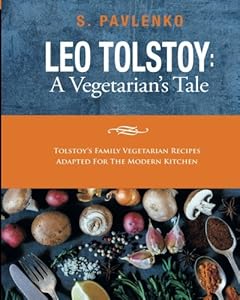After a mid-life crisis, Leo Tolstoy adopted a radical new diet. Now, a cookbook of his wife’s recipes has been translated into English – what better way to celebrate his birthday?
Marianna Hunt
Thu 6 Sep 2018 09.00 BST Last modified on Thu 6 Sep 2018 09.02 BST
Shares
961
Comments
12
A lemon pie recipe, from the Leo Tolstoy cookbook
‘A birthday without Ankovsky pie is the same as a Christmas without the Christmas tree’. Photograph: Marianna Hunt
When we think of the mighty pen that conjured up saucy opera house scandals in Anna Karenina and epic battles in War and Peace, the last thing that springs to mind is a long-haired, new-age hippy preaching peace, love and vegetarianism. But replace tie-dye T-shirts for a peasant’s smock, and that is exactly what became of Leo Tolstoy.
After a spiritual crisis around the time of his 50th birthday, the Russian literary giant gave up smoking, drinking, eating meat and even the rights to his own work. He became a staunch advocate of pacifism and a vocal supporter of vegetarianism.
Unfortunately for Tolstoy, 19th-century Russia was short on quinoa and Quorn. Instead he became obsessed with eggs, living off a rotating menu of 12 egg dishes including poached eggs with croutons, eggs with Brussels sprouts and beans, and omelette in soup. Sweet pastries and baked items were off-limits – except on birthdays and special occasions when Mrs Tolstoy would prepare a very sour lemon pie.
On 9 September 2018, Tolstoy turns 190. Hosting a birthday party for a peace-loving, cake-hating, alcohol-reviling (and dead) vegetarian is no mean feat. Luckily I have a trick up my sleeve.
In 1874, Tolstoy’s long-suffering wife, Countess Sophia Andreevna Tolstaya, received a gift from her brother: it was a joke recipe book of all the dishes Tolstaya had developed over the years to satisfy the gastronomic whims of her husband. In the book you can find everything from snippets of conversation at family meals to recipes for turnip porridge – there’s even instructions for macaroni cheese à la Tolstoy.
Sign up for Bookmarks: discover new books in our weekly email
Read more
Almost 150 years later, the cookbook has finally been translated and republished. It promptly went on my Kindle app and I set about getting an idea of what a 190th birthday party chez Tolstoy would have looked (and tasted) like.
“A birthday without Ankovsky pie is the same as a Christmas without the Christmas tree,” sighs Ilya, Tolstoy’s son, on one page. This seems as good a place to start as any. The pie, the book helpfully explains, is named after the family physician, Dr Anke, who introduced them to the dish. The book is less helpful when it comes to instructions. For the filling: rub together butter, sugar, eggs, and the zest and juice of three lemons. “Boil it all till it becomes as thick as honey” could well have been “till it becomes as clear as mud”.
For the base: flour, butter, sugar, eggs, and “one shot glass of water” (water –“вода”– and vodka –“водка”– are only separated by one letter in Russian; I secretly hope it’s a typo). On the subject of what to do with all of these, Tolstaya remains frustratingly silent. Luckily the modern editor has added a few pointers: I zest my lemons and crack five eggs – surely Tolstoy would approve of that.

Next, time for refreshments. What do you have to drink at the birthday party of a man who doesn’t drink? Fermented bread, of course.
Kvass, a beverage made from old rye bread, is a Russian delicacy and the table at Tolstoy’s estate at Yasnaya Polyana was never fully laid without a pitcher of the stuff. According to the recipe for “Fet’s Dried Crust Kvass”, all you need to do is mix seven pounds of dried brown crusts with four pails of boiling water in a wooden, thoroughly steamed tub and stir for an hour with a wooden dough paddle. Add sugar, mint branches and yeast, then leave to ferment. Right...
Getting creative, I put some old bread in the toaster to brown up a bit, fashion a makeshift dough paddle (whatever that is) out of a spatula, and grab a plastic washing up bowl for a tub. Ten hours and one smoke alarm later, the kvass is ready to bottle.
As I put the finishing touches to the table, I imagine myself bustling around the kitchen at Yasnaya Polyana, being occasionally interrupted by one of the Tolstoys’s 13 children or Tolstoy wandering in wearing his two hats (in his later years he got very sensitive to cold on his head). The recipe book’s main protagonist is Tolstaya herself who, aside from catering to all of her husband’s vegetarian wishes (she remained a staunch meat-eater until just before her death) and putting up with him turning up late to every meal, also transcribed by hand the entirety of War and Peace in its original form – seven times longer than the multi-tome version we know today.
Time to raise a toast, quite literally. I sink my teeth into a sharply acidic slice of Ankovsky pie and sip my malty glass of kvass. It’s a simple, but hopefully fitting tribute, to the man who takes 1,225 pages to come to the conclusion that (spoiler alert) the secret to a happy life is to sit and enjoy a salty baked potato while chatting to an old peasant in prison.
•
No comments:
Post a Comment